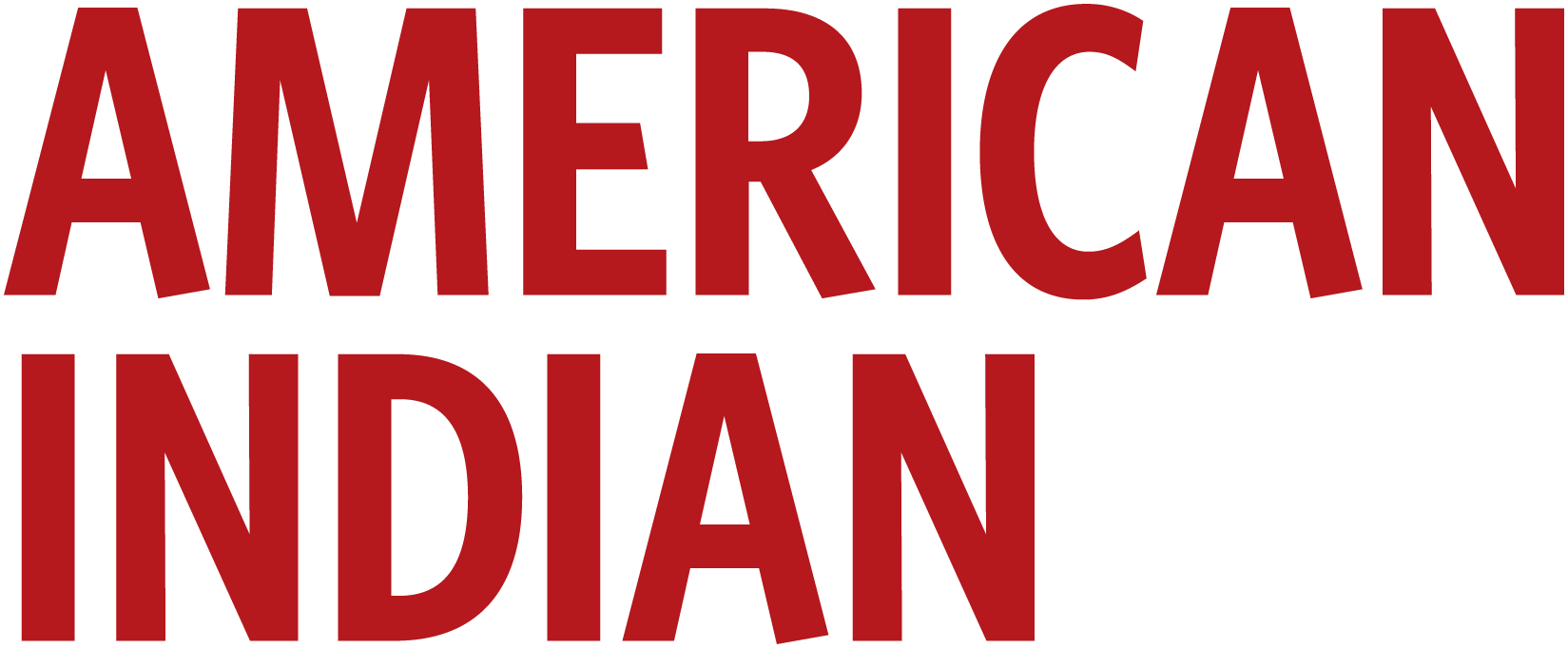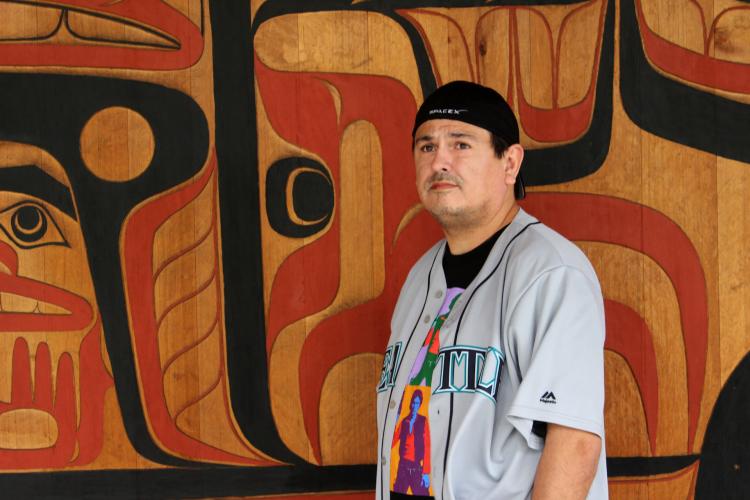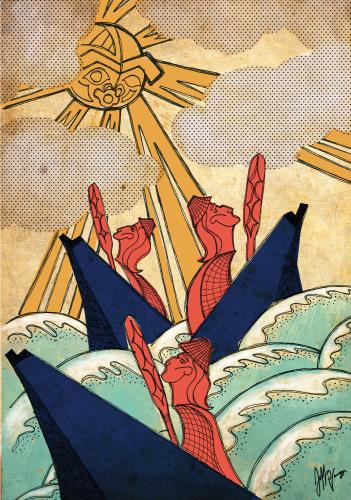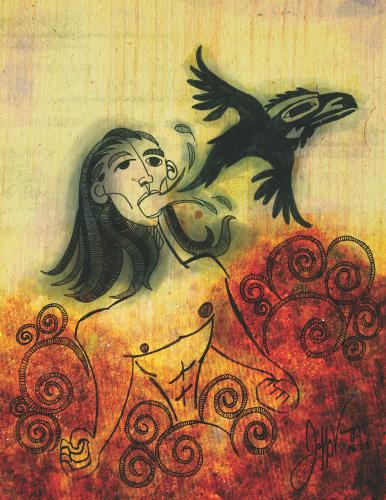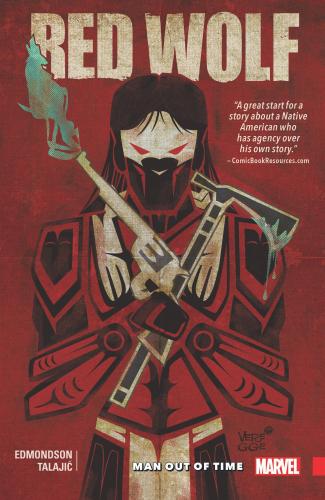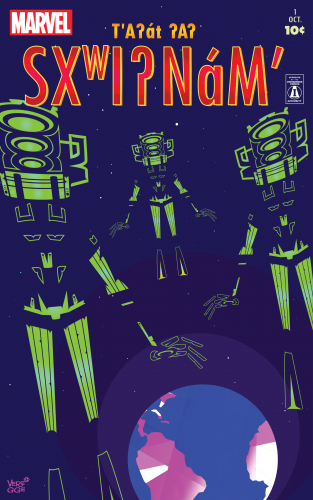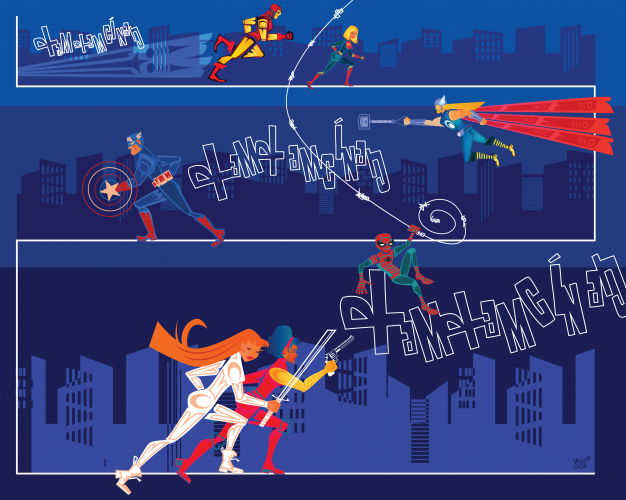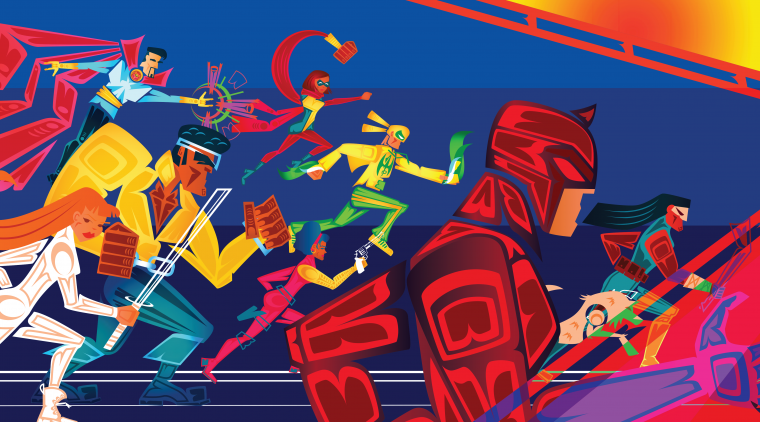New York seems to be a magnet for villainous extraterrestrials. Fortunately, in these terrifying scenarios we also have superheroes who are ever ready to defeat them. Yet in one such battle, 1950s-style flying saucers and giant Celestials are being foiled by an army of comic book heroes and heroines drawn in a style that evokes figures carved into totem poles or other Pacific Native artworks. Instead of “Kaboom!” or “Bam!,” the aliens shout “ɬəmɬəmcínəŋ!,” the Salish term for thunder. And the Marvel comic book characters fighting to defeat these invaders include not only stars of the silver screen—such as Iron Man, Black Widow and Hulk—but also those less often in the limelight, such as the Pakistani Ms. Marvel and the American Indian Red Wolf.
This epic “t'aʔmát ʔaʔ sx̣ʷiʔám',” or “stories of suspense,” is the creation of S'Klallam artist Jeffrey Veregge. Stretching across two immense murals—each 50 feet long and 8 feet tall— at the National Museum of the American Indian in New York, this “Jeffrey Veregge: Of Gods and Heroes” exhibit will be on display until October 13, 2019.
Kathleen Ash-Milby (Navajo), the exhibit’s curator, says the Museum commissioned the artwork from Veregge because “We saw his bold, graphic and imaginative work as ideal for our audience in New York, and we wanted to give him just the right opportunity that would allow him to create something new and specific to our location.”
Veregge’s unique style adapts the distinctive characteristics of North Pacific Coast Native art and infuses it into his own vision of science fiction and comic book stories—in essence creating his own alternate universe, not just in his works but in his life. As he says, “I break a lot of rules.”
Why “Of Gods and Heroes”? Veregge says he wanted to show that “the mythic tales and battles between the forces of good and evil never go away. That regardless for all our technology and advancements as a people, we still like to cling to the morality tales of super beings and gods. Even though the names of the heroes are not the same, the spirit of the art and message remains the same as it did thousands of years ago.”
Close to Home
Veregge is of Suquamish and Duwamish ancestry and a member of the Port Gamble S'Klallam Tribe. Historically, the Salishspeaking S'Klallam people lived from central British Columbia to northwestern Oregon. Today, the S'Klallam Nation includes the Port Gamble, Jamestown and Lower Elwha Tribes on the north coast of Washington State and the Scia'new First Nation on the south coast of Vancouver Island. Veregge spent the first 30 years of his life on the Port Gamble reservation and even now, he lives less than 30 miles away. “The tribe is my family. It is my home,” he says.
The S'Klallam are known as the Nux Sklai Yem, or Strong People, and their formline art certainly reflects that. The bold, black and color lines that form squat, concentric ovoid shapes distinguish what art historian Bill Holm first termed as “formline” in his 1965 book “Northwest Coast Indian Art: An Analysis of Form.” On the reservation, formline human and animal faces constantly peered at Veregge from paintings, buildings or engraved totem poles. “I was around it so much growing up,” he says, “it was engrained in who I am.”
However, as “a child of the 1970s,” Veregge was also influenced by the pop icons of his time. By the age of 4, he was drawing robots, “Star Wars” characters and his favorite comic book superheroes. “I understand the geek world better than anything,” he says. “I’ve been a geek my whole life.”
As an adult, he entered the Art Institute of Seattle with the intent of being either an action figure designer or Disney imagineer. After he graduated in 2000 with a degree in industrial design and technology, however, his first job was in marketing, creating advertising for nonprofit organizations. While he was glad that his work helped others, it didn’t feed his creative soul. “When I was a kid, a blank piece of paper was magic,” he says. “I lost that when I went to art school and then started working in marketing and painting commissions.”
Just six months later, his tribe asked him to create a logo for it. Intent on getting it right, he “looked at some books, drew what I thought looked good, but I couldn’t explain why I put some things where I put them. I didn’t want other Native artists to say I didn’t know what I was doing.” He had learned in art school, “If you are going to break the rules, explain why.” So in 2001, he asked to apprentice with Tsimshian artist and master wood carver David Boxley, who at that time lived not far from Veregge’s reservation. Boxley would later carve the totem pole that now stands in the atrium of NMAI in Washington, D.C. “His finished work was impeccable,” says Veregge. For six months, he studied Boxley’s traditional carving and drawing techniques. “You learn from the best.”
During the next 15 years, Veregge continued to paint, draw and design, taking inspiration from North Pacific Coast artists as well as other masters such as Pablo Picasso and Henri Matisse. He spent “many sleepless nights” creating commissioned pieces for galleries and other clients, but he didn’t feel like he was “doing any of it for me,” he says. And even though “seeds were planted in many spots,” he says, “it took a while for them to be harvested.”
True Native Heroes
Things changed after Veregge put his portfolio online. His work began to garner the attention of comic book fanzines, aficionados and publishers. In 2015, he was commissioned to draw covers for “G.I. Joe,” “Transformers” and “Judge Dredd.” Then he got a Facebook message from Marvel editor Joe Quesada telling Veregge to contact Marvel’s talent liaison. Soon after, he was asked to create pieces for an art show in Los Angeles to promote the “Avengers: Age of Ultron” movie. Just a few months later, he drew the first cover for the “Red Wolf” comic book that Marvel rebooted in December 2015.
Jake Thomas, assistant editor at Marvel, says, “The job of a comic book cover is to capture a reader’s attention, to make them desperately curious to know what is inside. Jeffrey Veregge’s art on ‘Red Wolf ’ did that in spades. His use of bright colors contrasted with dark negative space, playful design sense and deceptively simple yet effective use of primary shapes draw the eye and spark the imagination.”
Because, as Veregge says, “there are things in our culture that don’t translate out of the reservation,” he also served as a content consultant for the book, advising how the American Indian characters and scenes were portrayed. “Jeffrey was an invaluable member of the team,” says Thomas. His experience and input helped “shape the narrative and build Red Wolf into a complex and relatable hero in the mighty Marvel tradition.”
This was a pivotal moment for Veregge as well as for Marvel. Red Wolf was Marvel’s first American Indian character, premiering in the comic book “Avengers No. 80” in 1970. Although more than 100 American Indian comic book characters have been created since the Golden Age of Comics began in the 1930s, comic book publisher and founder of Indigenous Comic Con Lee Francis (Laguna Pueblo) says that historically the comic book industry has been “more interested in the trappings of the Native identity rather than the realities of Native identity.” Today, he says a true representation of an American Indian superhero in the mainstream media “is still a long way off. But in the indie world, where Native folks are writing, creating and publishing their own stuff, it is awesome. It is there.”
Veregge says while the comic book industry has made strides, he really wants to “see a Wakanda moment for Native American comics.” The “Black Panther” movie, he says, “has mass appeal because it was sharing a culture in a way that was honoring and respectful in a contemporary setting. Those characters are not shown as sidekicks or lesser heroes or villains. That world put them on the same level as Captain America or Thor, and in some cases, surpassed it.”
“Once we create a character that honors the values of Indian Country—we come closer with each comic book, each cover, each opportunity— eventually we will have our own Black Panther, Superman, Wonder Woman and Captain Marvel,” he says. “It might not be my generation that does it. … But I do have faith that it is coming down the road.”
Francis agrees the cure to portraying American Indians as stereotypes in comic books will be “more of our creatives as writers and in positions as decision makers, editors and executives. We need to be able to work in the bull pen.” Francis says that Veregge’s unique work and ability to navigate the industry “is the tip of the sword. We have so many folks that are going to come behind him.”
Reflections
Veregge now has illustrated more than 100 comic book covers, consulted on other Native comic stories and is even creating his own American Indian character. He says, “I’m having fun again.” Even a couple of Avengers have praised Veregge’s work through social media. Robert Downey Jr. commented “Love it!” on Facebook about his portrayal of Iron Man, and Mark Ruffalo posted a detail of the NMAI murals that includes the Hulk on Instagram, exclaiming, “This is beautiful!”
Yet what really matters to Veregge is that the murals can reflect the viewer and offer possibility. “I wanted kids to go to in there and see a character who is like them or where they are from,” says Veregge. “That they see a positive representation of who they are—and who they can be.”
That is just what happened to 10-year-old Daniel Cupido. Daniel’s mother, Onica Cupido, writer of “The Mommy Factor” blog, was born in Guyana and has lived in New York for the past 30 years. Cupido strives to expose her son to a wide range of cultures and frequently takes him to NMAI because its exhibits show that “Native American cultures are living. They are still here and are portrayed in a positive way.” Daniel says that seeing one of his favorite characters, Red Wolf, in the “Of Gods and Heroes” exhibit this past February, “was really cool,” because that comic book “taught me that superheroes might be Native Americans, too.”
So while the Avengers’ battles thundered across IMAX screens this year, Veregge’s murals have made their own big statement: a multiverse of heroes are out there. “We have created such a narrow view of who we think a people are that it makes it harder for the next generation to break down those barriers,” says Veregge. “I believe in Gene Rodenberry’s infinite diversity in infinitive combinations. That we can appreciate those differences—not just embrace them but find out how we can learn from them, how we can benefit from them as a species. I don’t think we do that enough. That is why I make my art. When I have opportunities such as this, I want to make sure that it is part of that in some small way.”
